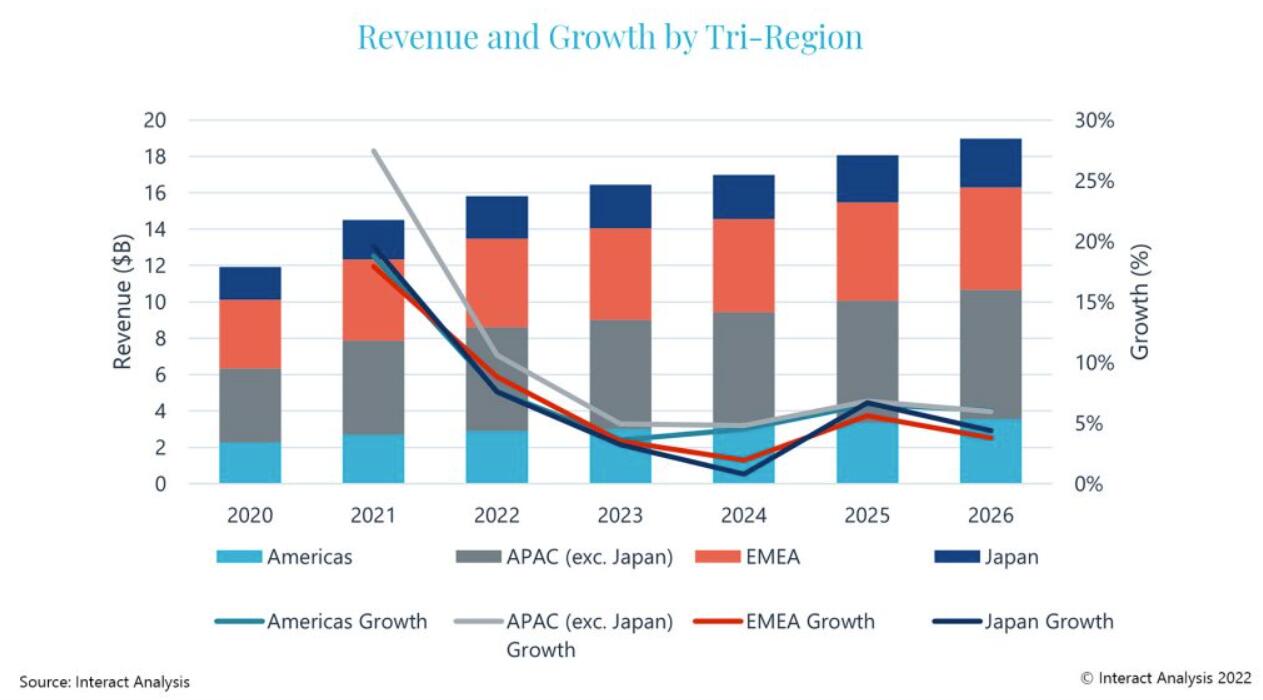运动控制市场预计到2026年将实现5.5%年均增长
http://www.gkong.com 2022-09-23 14:51 《中华工控网》翻译
Motion Control Market Predicted For 5.5% CAGR Out To 2026
运动控制市场预计到2026年将实现5.5%年均增长
Motion control products are used in all industries, wherever precise, controlled movements are required. This diversity means that, while many industry sectors currently face an uncertain future, our predictions for the motion control market remain relatively positive for the mid-to long-term, with $19bn of sales predicted for 2026, up from $14.5bn in 2021.
运动控制产品用于所有需要精确、受控运动行业。这种多样性意味着,尽管许多行业目前面临不确定的未来,但我们对运动控制市场的中长期预测仍然相对乐观,预计2026年的销售额为190亿美元,高于2021年的145亿美元。
Major factors impacting growth
影响增长的主要因素
The COVID-19 pandemic has had both a positive and a negative effect on the motion control market. On the positive side, there was an immediate boost in APAC, as many vendors in that region saw a significant expansion of markets as demand surged for the manufacture of pandemic products such as PPE and ventilators. A longer-term positive is the enhanced awareness of the need for more automation in factories and warehouses to future-proof production against further pandemics and solve the problem of labor shortages.
新冠大流行对运动控制市场同时产生了积极和消极的影响。从积极方面来看,亚太地区即时出现增长,因为该地区的许多供应商都看到了市场的显著扩张,对生产个人防护设备和呼吸机等流行病产品的需求激增。长期积极的一面是人们对工厂和仓库需要更多自动化的意识增强,以应对未来的大流行病并解决劳动力短缺问题。
On the negative side, at the height of the pandemic, short-term growth was stifled by factory closures and social-distancing measures. Also, suppliers found themselves focusing their efforts on production rather than research and development, potentially hindering future growth. Digitalization – the drive to Industry 4.0 and the Internet of Things will continue to drive motion control sales, as will the sustainability agenda, which will likely open up new markets for motion control products in new energy industries such as the wind turbine and li-ion battery sectors.
不利的一面是,在大流行最严重的时候,短期增长被工厂关闭和社会隔离措施所扼杀。此外,供应商发现自己将精力集中在生产而不是研发上,这可能会阻碍未来的增长。数字化——工业4.0和物联网的驱动力将继续推动运动控制的销售,可持续发展议程也将推动风力涡轮机和锂离子电池等新能源行业成为运动控制产品的新市场。
So there is plenty to feel positive about, but let’s not forget the two big problems many industries are currently struggling with – supply issues and inflation. Semiconductor shortages have slowed down the production of drives, and shortages of rare earth metals and raw materials have affected motor production. Meanwhile, shipping costs have spiralled, and strong inflation will almost certainly cause people to think carefully about investment in automation products.
因此,有很多值得乐观的地方,但我们不要忘记许多行业目前正在努力解决的两大问题——供应问题和通货膨胀。半导体短缺导致驱动器生产放缓,稀土和原材料短缺影响电机生产。与此同时,运输成本呈螺旋式上升,强劲的通货膨胀几乎肯定会导致人们认真考虑对自动化产品的投资。
APAC leads the way
亚太地区引领潮流
The relatively poor performance of the motion control market in 2020 led to reciprocal pressure in 2021 which inflated growth figures for that year. The post-covid rebound meant that total revenues grew from $11.9bn in 2020 to $14.5bn in 2021, representing a year-on-year market growth of 21.6%. APAC, notably China with its huge manufacturing and machinery production sectors, was the main driver behind this growth, accounting for 36% of global revenues ($5.17bn) and, not surprisingly, the region saw the highest growth – 27.4%.
2020年运动控制市场相对较差的表现导致2021年的相互压力,从而夸大了当年的增长数据。疫情后的反弹意味着总收入从2020年的119亿美元增长到2021年的145亿美元,市场同比增长21.6%。亚太地区,尤其是拥有庞大制造业和机械生产部门的中国,是这一增长的主要驱动力,占全球收入的36%(51.7亿美元),毫不奇怪,该地区的增长率最高,达27.4%。

Companies in the APAC region seemed better able to handle supply chain issues than their counterparts in other regions. But EMEA wasn’t far behind, generating motion control revenues of $4.47bn, making up 31% of the global market. The smallest region was Japan, with sales worth $2.16bn, accounting for a still not insignificant 15% of the global market. In terms of product type, servo motors led in 2021, with revenues of $6.51bn. Servo drives occupied the next largest market segment, generating revenues of $5.53bn.
亚太地区的公司似乎比其他地区的同行更能处理供应链问题。但欧洲、中东和非洲也不甘落后,产生了44.7亿美元的运动控制收入,占全球市场的31%。最小的地区是日本,销售额为 21.6亿美元,占全球市场的15%。在产品类型方面,伺服电机在2021年处于领先地位,收入为65.1亿美元。伺服驱动器占据第二大细分市场,创造了55.3 亿美元的收入。
$19bn sales predicted for 2026; up from $14.5bn in 2021
预计2026年销售额将达到190亿美元;高于2021年的145亿美元
So where is the motion control market going from here? Clearly, we cannot expect the high growth seen in 2021 to be sustained, but concerns about over-ordering in 2021 leading to cancellations in 2022 have not materialised so far and respectable growth 0f 8-11% is predicted for 2022. There will be a slowdown from 2023 onwards, though, as the general outlook for manufacturing and machinery production declines. However, the longer-run picture between 2021 and 2026 will still see the total global market increase from $14.5bn to $19bn, equating to a global CAGR of 5.5%.
那么运动控制市场将何去何从?显然,我们不能指望2021年的高增长会持续下去,但对 2021年过度订购导致2022年取消的担忧迄今尚未成为现实,预计2022年将实现8-11% 的可观增长。不过,随着制造业和机械生产的总体前景下降,从2023年开始放缓。然而,从 2021年到2026年的长期情况,全球市场总额仍将从145亿美元增加到190亿美元,相当于全球复合年增长率为5.5%。
APAC, where the motion control market will see a CAGR of 6.6% over the forecast period, will continue to be the dominant driver. China is predicted to see its market size grow from $3.88bn in 2021 to $5.33bn in 2026, an increase of 37%. Recent events have caused some uncertainty in China though. China fared well in the early onset of the pandemic, and exports of motion control products grew owing to increased demand from countries where production was disrupted by the virus. But the region’s current zero-tolerance battle with the virus means lockdowns in major port cities such as Shanghai could still hold back the local and global motion control market. The possibility of further lockdowns in China in the near future is probably the single biggest uncertainty that the motion control market currently faces.
亚太地区的运动控制市场在预测期内的复合年增长率将达到6.6%,继续成为主要驱动力。预计中国的市场规模将从2021年的38.8亿美元增长到2026年的53.3亿美元,增长37%。不过,最近的事件在中国造成了一些不确定性。中国在大流行初期表现良好,由于生产受到病毒干扰的国家的需求增加,运动控制产品的出口增长。但该地区目前对病毒的零容忍政策意味着上海等主要港口城市的封锁仍可能阻碍本地和全球运动控制市场。在不久的将来,中国进一步封锁的可能性可能是运动控制市场目前面临的最大不确定性。
相关新闻
- ▪ 2025年自动化及运动控制市场趋势洞察分析
- ▪ 西门子运动控制业务研发创新中心正式投入运营
- ▪ 施耐德电气 Modicon M310 新品发布,总线型运动控制的绝佳伙伴!
- ▪ 派克汉尼汾推出适用于现场监测和诊断的测量设备 Service Master COMPACT
- ▪ 数智进化,驱控未来 | 埃斯顿运动控制OPEN DAY暨新品发布会圆满完成
- ▪ Aerotech 发布Automation1 2.7 激光振镜和更多用户功能升级
- ▪ 莱迪思发布先进的运动控制解决方案
- ▪ 关注客户,聚焦服务,加速增长 | 2024年ABB中国运动控制重点服务渠道伙伴会议
- ▪ 施耐德电气运动控制家族添新,Modicon M310运动控制器发布
- ▪ ADI:使用智能解决方案优化效率




